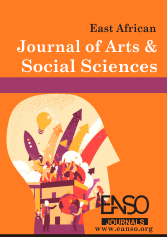Melodrama Tropes as Language Registers of Trauma in the Gacaca Trilogy
Abstract
This paper examines how melodrama tropes function as language registers of trauma in one of the Gacaca Trilogy: Living Together Again in Rwanda (Aghion, 2003). Therefore, the paper sought to interrogate how the documentary employed melodrama tropes as a narrative framework technique to depict narrative registers of trauma. Initially, the paper explored the melodrama trope of recognition, rooted in a symbolic Manichean worldview, to narrate the major conflicts of the selected trilogy. Therefore, it scrutinised how the trilogy's narrative structure is constructed around moral oppositions of 'good and evil' to represent trauma, and secondly, it examined melodrama's last-minute rescue trope that narrated sudden interventions that saved a character from despair. The paper employed a multi-modal transcription method for decoding primary data, and the findings were interpreted using narratological and literary trauma theories. The paper revealed that Manichean and last-minute melodramatic tropes function as key narrative devices that encode traumatic experiences, shaping the documentary's registers of trauma. In addition, the paper concluded that these melodrama tropes mediate the representation of war trauma, contributing to broader discourses on memory, violence, and the narrative structure of the Gacaca trilogy
Downloads
References
Aghion, E. (Director). (2003). Gacaca: Living together again in Rwanda [Film]. Gacaca Films. https://gacacafilms.com/
Aghion, E. (Ed.). (2005). In Rwanda we say: The family that does not speak dies [Film]. Gacaca Films. https://gacacafilms.com/
Aghion, E. (Director). (2009). The notebooks of memory [Film]. Gacaca Films. https://gacacafilms.com/
Alexander, J. C. (2012). Trauma: A social theory. Polity Press.
Caruth, C. (1996). Unclaimed experience: Trauma, narrative, and history. Johns Hopkins University Press.
Clark, P. (2010). The Gacaca courts, post-genocide justice and reconciliation in Rwanda. Cambridge University Press.
Des Forges, A. (1999). Leave none to tell the story. Human Rights Watch
Felman, S., & Laub, D. (1992). Testimony: Crises of witnessing in literature, psychoanalysis, and history. Routledge.
Fujii, L. A. (2009). Killing neighbors: Webs of violence in Rwanda. Cornell University Press.
Herman, J. L. (1992). Trauma and recovery: The aftermath of violence—from domestic abuse to political terror. Basic Books.
Hsieh, H.-F., & Shannon, S. E. (2005). Three approaches to qualitative content analysis. Qualitative Health Research, 15(9), 1277– 1288. https://doi.org/10.1177/1049732305276687
LaCapra, D. (2001). Writing history, writing trauma. Johns Hopkins University Press.
Lifton, R. J. (1986). The Nazi doctors: Medical killing and the psychology of genocide. Basic Books.
Marcantonio, C. (2015). Global melodrama: Nation, body, and history in contemporary film. Palgrave Macmillan
Mamdani, M. (2001). When victims become killers: Colonialism, nativism, and the genocide in Rwanda. Princeton University Press.
Palys, T. (2014). Research decisions: Quantitative, qualitative, and mixed methods approaches. Nelson Education
Straus, S. (2006). The order of genocide. Cornell University Press.
Tal, K. (1996). Worlds of hurt: Reading the literatures of trauma. Cambridge University. Press.
United Nations. (1999). Report of the Independent Inquiry into Rwanda.
Copyright (c) 2025 Duke Nyakoria Abuga, Bwocha Nyagemi Bwocha, PhD, Christopher Okemwa, PhD

This work is licensed under a Creative Commons Attribution 4.0 International License.




























